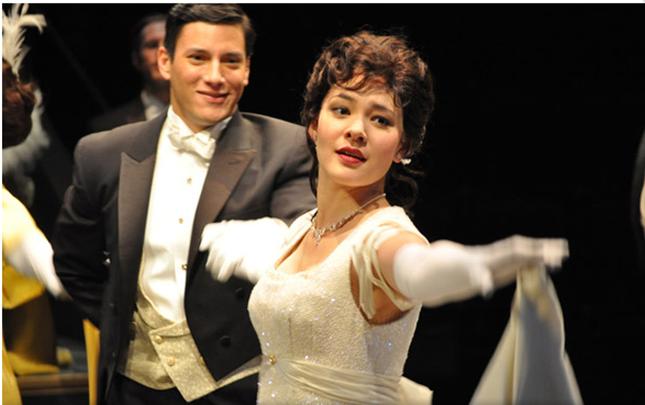This Refreshed ‘Fair Lady’ Learns Anew at Arena
By • December 6, 2012 0 687

The trouble with the Arena Stage production of “My Fair Lady” is that it’s “My Fair Lady.”
That being said—and more will be said—I thought and more importantly felt that this production of the Alan Jay Lerner and Frederick Loewe stage (and movie) classic musical was fresh. It belongs to the audience of these our times as much as it did for previous generations without neglecting any of the great score and work of L&L. While long at nearly three hours, this production also had something that energized the evening. Being a musical based on George Bernard Shaw’s “Pygmalion,” it had pungent, prickly Shavian smarts in the script on the subject of gender and class, emotionally and intellectually executed, sung and acted.
What did it not have? It did not have Rex Harrison inimitably speaking his songs. It did not have a dubbed Audrey Hepburn. It did not have Stanley Holloway’s English vaudevillian turn as Eliza Doolittle’s dad, getting to the church on time.
I mention these things because the film version of “My Fair Lady” is so much in the mind of theater audiences or new audiences, not to mention critics, that it’s hard to shake, especially when confronted with stage productions that cannot hope to or want to reproduce the effects and affectations of the film version.
“My Fair Lady” has its own, original charms, virtues and passions.
What I saw and felt was a successful and fully loaded attempt to offer up the rich musical, dramatic gifts that “My Fair Lady” has to offer through inventive staging, casting and costuming and sets. In this, casting Shaw Festival and Canadian veteran Benedict Campbell as Henry Higgins (he comes from Smith’s original SF production staged earlier this year), and relative newcomer Manna Nichols as Eliza Doolittle was critical, leading a standout cast up and down the line. Campbell is an excellent and experienced actor who can sing while Nichols is a wonderful singer who can act. In this production, something happens that I’ve rarely if ever seen in the show—film and two other productions—I was moved by where the relationship between Eliza and Henry was heading and ended up, an ending that’s often mystifying to lovers of romantic endings in musicals.
“My Fair Lady” remains the same story—Shavian in its intellectual content, so very L&L in its musical themes. The noted linguist Henry Higgins, bets his old friend Colonel Pickering that he can turn Eliza Doolittle, a dirty, near unintelligible Cockney flower girl (he calls her than once a “guttersnipe”) into a countess by teaching her—in a rigid, slave-driving regimen—how to speak the King’s English. In England, class was defined by how you spoke the language (and dressed, and went to school and so on). Bloody hell, you might say, and she probably did, but agrees to participate. Using repetition, sometimes Pavlovian starvation, and sleep deprivation, Higgins slowly turns the scruffy but moral (“I’m a good girl, I am) working-class girl into someone lady-like, mannered and well-mannered and powerfully and fashionably attractive, at that.
All the familiar strains are here—the test run at the races where Eliza relapses in high and low fashion—a meeting with Higgins’s mum, and the ball where she conquers all, especially poor Freddy, the handsome scion of an artistocratic family. That would be Nicholas Rodriguez, who gets to sing the achingly yearning “On the Street Where You Live” and turns it into a show stopper, just as he turned “Oh, What a Beautiful Morning” into a roaring show starter in “Oklahoma.”
Nichols, elfin and shining, puts a swirling, dreamy, sweeping quality in her voice singing the songs that wish like “I Could Have Danced All Night” and “Wouldn’t It Be Loverly.” Campbell actually sings and moves with power through the thoroughly misogynist “Hymn To Him.” “The Rain In Spain” number, sung by Eliza, Higgins and Pickering, is high-spirited and fun.
The folks on the poor side of town—the bartenders, the chimney sweeps, the flowers girls, the cabbies, including Eliza’s father Alfred Doolittle are a different sort, and so is Doolittle himself. Their clothing in brash steampunk style—it sometimes harks back to the 1960s hippie style as well—and their diversity speak to a multi-ethnic (The Doolittles are part Asian here) world that existed in London then and does so now as well as here. Daddy Doolittle’s “Get Me to the Church” is no longer specifically London cockney or vaudeville, it’s a paean to the group, into which James Saito often disappears in the role.
What’s clear in this show is how through their battling, Henry and Eliza find not only each other but themselves. While Eliza hardly lacks passion, in the end she’s not interested in a future with the smitten Freddie. She wants something more substantive, and that would be Henry Higgins. The more she knows about herself and her own gifts, the more she’s a match for Henry. And the more Higgins—the confirmed old bachelor type who prefers solitude and subsists on arrogant intellectual superiority—is around Eliza, the more he realizes she completes him—that missing human part that includes longing.
This “My Fair Lady” is what it is: something pretty special. It delivers the old goods and the new.

